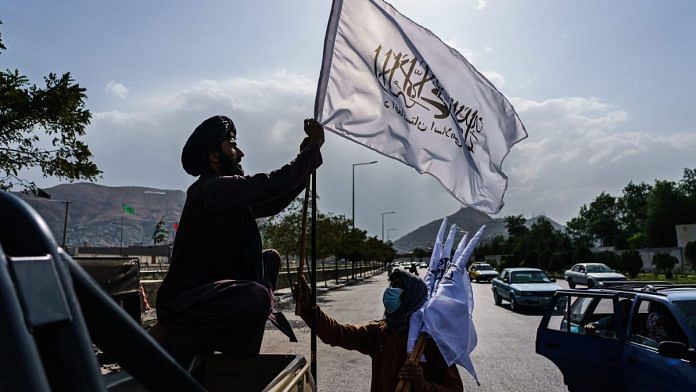New Delhi: With their return to power in Afghanistan last month, the Taliban’s white-and-black banner has replaced the earlier Afghan national flag atop most government buildings, police stations and military establishments.
However, this has sparked several protests across the country, with one such protest in Jalalabad in August resulting in the deaths of three Afghans, and injuries to several others.
Videos circulating on social media also showed Afghans climbing poles at the famous Abdul Haq Square in Kabul to hoist the old tricolour, featuring vertical bands of black, red and green and the seal of a mosque, in defiance of the Taliban rule.
Afghans erecting national flag in Abdul Haq square in #Kabul, in defiance of Taliban
The militants have replaced the black, red, and green national flag with their own white flags across #Afghanistan
But Afghans are braving threats, possible violence to mark Independence Day pic.twitter.com/xtFKL9ygxh
— Frud Bezhan فرود بيژن (@FrudBezhan) August 19, 2021
But what does the Taliban flag symbolise, and how did it come about? ThePrint explains.
Also read: World wanted a Berlin moment in Afghanistan. It got a Taliban flag over Panjshir instead
Same inscription as old flag
The Taliban flag is white in colour with an inscription at its centre, in black. The inscription, in fact, is the same one that featured on the previous black-red-green flag, albeit displayed more prominently: ‘La ilah illallah, Muhammadur rasoul Allah‘, which translates to “There is no god but Allah, and Muhammad is the messenger of Allah”.
This inscription, known as the Shahada, is the Muslim proclamation of faith, and is an Islamic oath, the first of the Five Pillars of Islam cited in the Quran. The other four are prayers, alms, fasting and pilgrimage.
The white flag also has ‘Islamic Emirate of Afghanistan’ written on it, which is the new official name of the country announced by the Taliban after installing a caretaker government Tuesday.
The flag has been in use for two decades, since the Taliban’s rise to power in the 1990s.
When the militant Islamist group first took power in 1996, the flag was plain white, symbolising “the purity of their faith and government”. The group added the Shahada in black a year later.
Also read: Afghanistan’s new Taliban govt has a clear Pakistan stamp and that’s bad news for India
Afghanistan’s multiple flags
Afghanistan’s national flag has changed at least 18 times over the past hundred years since it gained independence from Britain in 1901.
During King Amanullah’s rule, starting 1926, the flag was plain black, with a white seal of a Mecca-facing mihrab (prayer niche) and a wreath.
It was then redesigned by Mohammed Nadir Shah, Amanullah’s cousin, in 1929, into a tricolour with black, red and green bands with Amanullah’s seal at the centre.
In 1974, the orientation of the tricolour was changed from vertical to horizontal bands, and a golden-colored eagle was added in the corner.
From 1974 to 2004, the flag was changed multiple times, including to the Taliban flag from 1996 to 2001. The Afghan national flag that the Taliban have now replaced was finalised in 2013.
Other militants groups’ flags
The flag used by the Islamic State is basically the inverse of the Taliban flag: It is a black banner with the Shahada written in white. When ISIS first came into being in 2006, it did not have a flag of its own. It was only a year later that al Qaeda’s media distribution arm, al-Fajr, released an image of the flag, which was named “the eagle”.
The current flag of the Northern Alliance of Afghanistan, the resistance movement against the Taliban, is also very similar to the earlier Afghan national flag, and features green, white and black bands, with no text.
Also read: Pakistan and China are preparing for a Taliban govt they don’t trust. So should India



